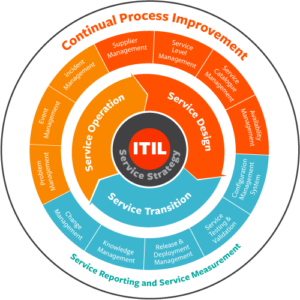IT service management is prevalent in larger organizations, but other organizations are still looking at implementing ITSM and haven’t taken the plunge yet. Chances are good some of those same shops have created their own do-it-yourself service delivery models over the years, so they don’t see the value in switching to a formal ITSM environment yet. After all, why change something that’s not broken?
In today’s post I’ll attempt to answer the question, “Why bother implementing ITSM if what you have is working fine?” I’ll highlight three specific benefits most companies experience when implementing ITSM inside an ITIL v3 framework.
Download Now: ITIL 4 Best Practice e-Books
These all-new for 2020 ITIL e-books highlight important elements of ITIL 4 best practices. Quickly understand key changes and actionable concepts, written by ITIL 4 contributors.
(Note: This post focuses on the benefits you receive when implementing ITSM with ITIL v3. The newer ITIL 4 standard, which debuted in 2019, has a different focus and provides different benefits.)
Top 3 benefits of implementing ITIL v3
In my experience, here are the top three outcomes you’ll realize when implementing ITIL v3 in your ITSM environment:
-
- A consistent framework for creating, delivering, evaluating, improving, and ultimately retiring IT services.
- Standardized IT service delivery through an organization-specific IT service catalog.
- Consistently defined IT roles for dealing with IT services that have failed, including:
- Fixing root causes of persistent problems
- Monitoring services
- Taking appropriate actions when an exception occurs in a running service or configuration item
1. ITSM and ITIL v3 provide a continual framework to deploy, improve, and retire services
The ITIL service lifecycle provides a framework for creating, deploying, delivering, improving, and retiring IT services, through these five core areas.

Figure 1: The ITIL service lifecycle
- The ITIL Service Strategy core areahelps you create a service portfolio that consists of the service pipeline, the service catalog, and retired services. It provides a past, present, and future view of what services an organization offers, has offered, or will offer to its customers. The service pipeline tracks services that have been proposed or are being developed, while the service catalog exposes all the available services that a customer can order now. Retired services are kept for reference and possible reactivation or redevelopment as pipeline services.
- The ITIL Service Design core area provides the roadmap for adding or changing services in the ITSM/ITIL environment.
- The ITIL Service Transition core area defines how IT services move from one state to another in the service portfolio, transitioning from pipeline to catalog to retirement.
- The ITIL Service Operation core area helps organizations insure that their IT services are delivered effectively and efficiently, through incident management, problem management, and event management (more in a minute).
- The ITIL Continual Process Improvement (CPI) core area defines the effectiveness of IT services, and provides a template for how services are evaluated, improved, monitored, and corrected.
The ITIL v3 service lifecycle helps you define and setup standard processes for how IT services are created, delivered, evaluated, improved, and ultimately retired. It provides industry standard practices and consistency for your IT service delivery and management, more so than with a DIY service management solution that may date to a previous decade.
2. ITSM and ITIL v3 standardize IT service delivery through a service catalog
The ITIL v3 framework helps you develop a standardized framework for users to request and receive services. An IT service catalog provides a single point of contact for customers requesting a specific service or requesting help when an incident occurs.
Organization that lack an ITSM framework typically have separate (frequently home-grown) interfaces for user adds, deletes, and changes; IT requests; and help desk tickets. Developing an ITIL v3 service catalog and service desk for your customers provides a standardized one URL structure for requesting and receiving IT services, cleaning up the myriad interfaces that a customer might have to navigate when they are looking for something.
3. ITSM and ITIL v3 offer a standardized framework for dealing with IT incidents, problems, and events
ITIL also helps provide consistency and defined roles when IT service delivery goes wrong, including:
- Incident management that responds to unplanned interruptions in IT services, where the goal is to restore the service as soon as possible. An example of an incident would be an application failure that corrupts an in-process order, where the fix is to correct the order so it can be processed.
- Problem management that identifies and corrects the underlying root causes (problems) causing multiple recurring incidents. A typical problem management situation might involve identifying why a customer ordering application occasionally crashes (causing incidents with order entry and fulfilment) and fix the app.
- Event management for constantly monitoring IT services or configuration items that are changing from one state to another, determining which event changes are normal and which event changes are exceptions. A change of state can be normal (e.g., an IBM i system has entered backup mode at its usually scheduled time) or it can be an exception (e.g., an IBM i system did not exit from backup mode at its expected time). Since not every system event needs attention, event management filters each event, determines which events are exceptions, and initiates the appropriate actions and alerts for any exceptions it finds.
Applying the practices listed in the ITIL v3 Service Operations core areas, organizations can set up processes to restore IT services that have been interrupted, repair root causes that result in multiple incidents, and initiate responses and alerts for IT services that need attention as they change state.
Additional resources
These are only three of the most valuable advantages in implementing ITSM and ITIL v3. Your organization can realize several additional advantages that can be realized with ITIL and ITSM.
For more information on IT service management, browse our ITIL v3 Guide, with 20+ articles on ITIL v3. Ready for the only end-to-end ITSM and ITOM platform for your company? Explore BMC Helix.








